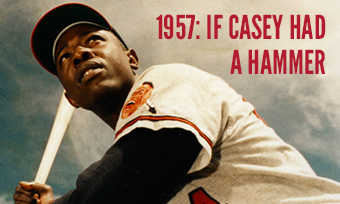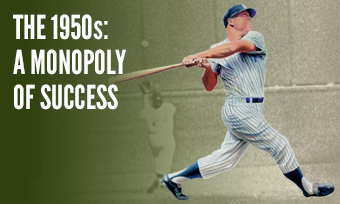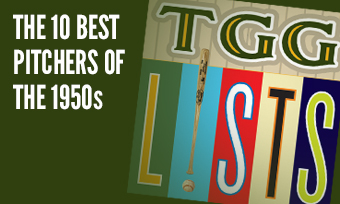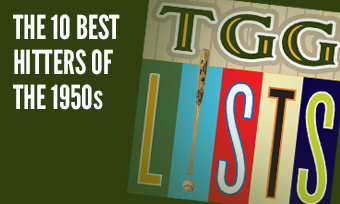The Yearly Reader
Leaders and Honors, 1957
Our list of baseball’s top 10 hitters and pitchers in both the American League and National League for the 1957 baseball season, as well as the awards and honors given to the game’s top achievers of the year.
The National League’s Top 10 Hitters, 1957
Bold type in brick red indicates league leader.
1. Willie Mays, New York
Key Numbers: .333 average, 112 runs, 195 hits, 26 home runs, 20 triples, 35 home runs, 97 RBIs, 75 walks, 38 stolen bases, 19 caught stealing, .626 slugging percentage.
Mays helped make the Giants’ New York coda a memorable one as he was the third National Leaguer to total 20 doubles, triples and home runs each.
2. Hank Aaron, Milwaukee
Key Numbers: .322 average, 118 runs, 198 hits, 27 doubles, 6 triples, 44 home runs, 132 RBIs.
In winning the NL MVP, Aaron helped give the Braves their only instance of the team fielding both MVP and Cy Young Award (Warren Spahn) recipients.
3. Stan Musial, St. Louis
Key Numbers: 134 games, .351 average, 82 runs, 176 hits, 38 doubles, 29 home runs, 102 RBIs, 67 walks, 19 intentional walks, .422 on-base percentage, .612 slugging percentage.
A wonderful year for Stan the Man; he captured his seventh (and last) batting crown, knocked out his 3,000th hit and drove in 100 runs for the 10th (and last) time—all at the tender age of 36.
4. Ernie Banks, Chicago
Key Numbers: 156 games, .285 average, 113 runs, 169 hits, 34 doubles, 6 triples, 43 home runs, 102 RBIs, 70 walks.
Let’s play two every day; Banks began the happy stage of his Hall-of-Fame career, hitting 40-plus homers for the first of four straight years.
5. Eddie Mathews, Milwaukee
Key Numbers: .292 average, 109 runs, 167 hits, 28 doubles, 9 triples, 32 home runs, 94 RBIs, 90 walks.
The slugger hit most of his home runs (19) away from County Stadium—but then again, so did the Braves, who launched a then-record 124 on the road.
6. Gil Hodges, Brooklyn
Key Numbers: .299 average, 94 runs, 173 hits, 28 doubles, 7 triples, 27 home runs, 98 RBIs.
Brooklyn would miss Hodges—and vice versa, as he finished a 10-year run based at Ebbets Field averaging 30 homers and 104 RBIs per season. The fade would begin for the 34-year old the following year in Los Angeles.
7. Frank Robinson, Cincinnati
Key Numbers: .322 average, 97 runs, 197 hits, 29 doubles, 5 triples, 29 home runs, 75 RBIs, 12 hit-by-pitches, 10 stolen bases.
In a relatively muted but still highly productive encore to his 1956 rookie campaign, Robinson was one of the few Reds who deserved All-Star recognition from overzealous Cincinnati voters who stuffed the ballots.
8. Duke Snider, Brooklyn
Key Numbers: 139 games, .274 average, 91 runs, 25 doubles, 7 triples, 40 home runs, 92 RBIs, 77 walks, 104 strikeouts.
No one was going to miss Ebbets Field more than Snider, who launched 40 homers for the fifth straight year; he’d only hit more than 20 once more in the next (and final) seven years of his career.
9. Ed Bouchee, Philadelphia
Key Numbers: .293 average, 78 runs, 168 hits, 35 doubles, 8 triples, 17 home runs, 76 RBIs, 84 walks, 14 hit-by-pitches.
The Montana-born Bouchee would experience his finest days as a 1957 rookie, but even with fellow top first-year pitcher Jack Sanford, their efforts would only be enough to pull the Phillies to an even .500.
10. Wally Moon, St. Louis
Key Numbers: .295 average, 86 runs, 28 doubles, 5 triples, 24 home runs, 73 RBIs.
The fourth-year outfielder set a personal best with 24 homers; he wouldn’t even hit that many with the Dodgers in later years while being celebrated for his “Moon Shots” over the driving range-like netting at the Los Angeles Memorial Coliseum.
The American League’s Top 10 Hitters, 1957
1. Mickey Mantle, New York
Key Numbers: .365 average, 121 runs, 173 hits, 28 doubles, 6 triples, 34 home runs, 94 RBIs, 146 walks, 23 intentional walks, 16 stolen bases.
In winning his second straight AL MVP, Mantle added to his fast-growing Hall-of-Fame résumé with the highest batting average ever by a switch-hitter.
2. Ted Williams, Boston
Key Numbers: 132 games, .388 average, 96 runs, 163 hits, 28 doubles, 38 home runs, 87 RBIs, 119 walks, 33 intentional walks, .526 on-base percentage, .731 slugging percentage.
The ageless Williams (39) recorded the majors’ highest batting average since his fabled .406 mark 16 years earlier, and collected two of his three career home run hat tricks—but he still finished second in AL MVP voting by a slim 24 votes to Mantle, as his chances were once again hampered by two writers (presumably Boston-based) who picked him ninth and tenth in the voting.
3. Roy Sievers, Washington
Key Numbers: .301 average, 99 runs, 172 hits, 23 doubles, 5 triples, 42 home runs, 114 RBIs, 76 walks.
With the help of Griffith Stadium’s ever-shrinking outfield real estate, Sievers became the only Senator to pace the AL in homers before the team’s move to Minnesota.
4. Minnie Minoso, Chicago
Key Numbers: .310 average, 96 runs, 176 hits, 36 doubles, 5 triples, 12 home runs, 103 RBIs, 79 walks, 21 hit-by-pitches, 18 stolen bases, 15 caught stealing.
Minoso would only hit three home runs at spacious Comiskey Park, none after June 16; a trade to Cleveland after the season would help ramp his power back up.
5. Vic Wertz, Cleveland
Key Numbers: .282 average, 84 runs, 28 home runs, 105 RBIs, 78 walks, 11 sacrifice flies.
The veteran first baseman continued to admirably fill in the Cleveland power gap vacated by Al Rosen and Larry Doby, and soon to be filled by Rocky Colavito.
6. Gene Woodling, Cleveland
Key Numbers: 133 games, .321 average, 25 doubles, 19 home runs, 78 RBIs, 64 walks.
Back to a level comparable (if not better) than his early-decade tenure with the Yankees, Woodling set career highs in batting average, homers and RBIs—and saved his best for his ex-New York mates, scoring season-high totals of five homers and 21 RBIs against them.
7. Nellie Fox, Chicago
Key Numbers: 155 games, .317 average, 110 runs, 196 hits, 27 doubles, 8 triples, 6 home runs, 61 RBIs, 75 walks, 16 hit-by-pitches.
Fox began a streak of 76 straight games at his home park (Comiskey Park) without striking out once.
8. Jackie Jensen, Boston
Key Numbers: .281 average, 82 runs, 29 doubles, 23 home runs, 103 RBIs, 75 walks, 22 grounded into double plays.
The Red Sox’ 1950s version of Bobby Doerr continued to effectively bring them home—but also couldn’t shake his nasty habit of hitting into twin-killings, leading the AL for the third time in four years.
9. Al Kaline, Detroit
Key Numbers: .295 average, 83 runs, 170 hits, 29 doubles, 23 home runs, 90 RBIs, 11 stolen bases.
Mr. Kaline could have been confused for Mr. Konsistency, hitting between .290 and .314 in the season’s five full months—but he did produce a power spike with 12 of his 23 home runs in August.
10. Charlie Maxwell, Detroit
Key Numbers: 138 games, .276 average, 75 runs, 24 home runs, 82 RBIs, 76 walks.
Kaline’s muscular sidekick for the time, Maxwell made his second All-Star appearance in as many full-time seasons.
The National League’s Top 10 Pitchers, 1957
1. Warren Spahn, Milwaukee
Key Numbers: 2.69 ERA, 21 wins, 11 losses, 3 saves, 39 appearances, 35 starts, 18 complete games, 271 innings, 24 grounded into double plays.
Like Stan Musial and Ted Williams, the 36-year-old Spahn showed off how cool it was to be old by leading the NL in wins for the first of five straight years.
2. Bob Buhl, Milwaukee
Key Numbers: 2.74 ERA, 18 wins, 7 losses, .720 win percentage, 31 starts, 216.2 innings, 121 walks, 11 caught stealing/picked off, 33 grounded into double plays.
Buhl managed an exact duplicate of his totals in wins and innings pitched from the year before, but improved in the ERA department, at nabbing baserunners and inducing double play grounders.
3. Don Drysdale, Brooklyn
Key Numbers: 2.69 ERA, 17 wins, 9 losses, 34 appearances, 29 starts, 221 innings.
Drysdale will always be associated with the Los Angeles Dodgers, but for one solid year he gave the folks at Flatbush something to remember.
4. Johnny Podres, Brooklyn
Key Numbers: 2.66 ERA, 12 wins, 9 losses, 3 saves, 31 appearances, 27 starts, 6 shutouts, 196 innings, 44 walks.
After a year in the Navy, Podres returned and led the NL in ERA and shutouts.
5. Lew Burdette, Milwaukee
Key Numbers: 3.72 ERA, 17 wins, 9 losses, 37 appearances, 33 starts, 256.2 innings, 59 walks, 30 grounded into double plays.
Burdette didn’t reach 20 wins—unless you count the three he nailed down against the Yankees in the World Series.
6. Bob Friend, Pittsburgh
Key Numbers: 3.38 ERA, 14 wins, 18 losses, 40 appearances, 38 starts, 277 innings.
An epitomizing year for the Pirates ace: Solid ERA, underwhelming record. Bad run support was one issue; so was bad defense, which allowed more runners to reach by error when Friend was on the mound than any other NL pitcher.
7. Jack Sanford, Philadelphia
Key Numbers: 3.08 ERA, 19 wins, 8 losses, .704 win percentage, 33 starts, 236.2 innings, 12 wild pitches, 188 strikeouts.
In arguably his most effective year as a pitcher amid a 12-year career, the 28-year-old rookie shared space on the first-year award parade with teammate Ed Bouchee, who won Sporting News rookie honors while Sanford garnered the BBWAA trophy.
8. Larry Jackson, St. Louis
Key Numbers: 3.47 ERA, 15 wins, 9 losses, 41 appearances, 22 starts, 210.1 innings, 57 walks, 26 grounded into double plays.
After a season all but fully spent in the bullpen, Jackson was eased back toward rotation duty—but was still at his stingiest when relieving, posting a 1.91 ERA as opposed to 4.04 as a starter.
9. Curt Simmons, Philadelphia
Key Numbers: 3.44 ERA, 12 wins, 11 losses, 32 appearances, 29 starts, 212 innings, 50 walks.
While Robin Roberts continued his sharp decline and rookie Jack Sanford made his presence felt, Simmons continued to provide the element of stability within the Phillies’ rotation.
10. Vern Law, Pittsburgh
Key Numbers: 2.87 ERA, 10 wins, 8 losses, 31 appearances, 25 starts, 172.2 innings, 32 walks.
One of the many young Pirates who absorbed a prolonged baptism of torture throughout the early 1950s, Law turned the corner toward the better portion of his career.
The American League’s Top 10 Pitchers, 1957
1. Frank Sullivan, Boston
Key Numbers: 2.73 ERA, 14 wins, 11 losses, 31 appearances, 30 starts, 240.2 innings, 48 walks, 21 grounded into double plays.
The tougher the situation, the better Sullivan pitched; batters hit just .198 against him with runners in scoring position, and .167 with the bases loaded.
2. Tom Sturdivant, New York
Key Numbers: 2.54 ERA, 16 wins, 6 losses, .727 win percentage, 28 starts, 201.2 innings, 15 caught stealing/picked off.
On Yankees manager Casey Stengel’s bingo card of rotation choices, Sturdivant emerged as the winner with the team lead in wins and starts.
3. Dick Donovan, Chicago
Key Numbers: 2.77 ERA, 16 wins, 6 losses, .727 win percentage, 28 starts, 16 complete games, 220.2 innings, 45 walks, 24 grounded into double plays.
Donovan’s stellar slider must have been in top form as he threw the only two one-hitters of his career in 1957.
4. Billy Pierce, Chicago
Key Numbers: 3.26 ERA, 20 wins, 12 losses, 37 appearances, 34 starts, 16 complete games, 257 innings.
The White Sox’ offense must have been coming around; the typically unsupported Pierce won 20 games for the second straight year.
5. Bobby Shantz, New York
Key Numbers: 2.45 ERA, 11 wins, 5 losses, 5 saves, 30 appearances, 21 starts, 173 innings, 40 walks, 22 grounded into double plays.
Soon to be transformed into a full-time reliever, Shantz grabbed the AL ERA title in his last year pitching enough innings to qualify.
6. Connie Johnson, Baltimore
Key Numbers: 3.20 ERA, 14 wins, 11 losses, 35 appearances, 30 starts, 242 innings, 1 stolen base allowed, 12 caught stealing/picked off.
Finally receiving decent support in his fourth year at the major league level, Johnson was one of the primary reasons the Orioles had their best non-wartime staff ERA since 1922 when they were the St. Louis Browns.
7. Jim Bunning, Detroit
Key Numbers: 2.69 ERA, 20 wins, 8 losses, .714 win percentage, 45 appearances, 30 starts, 267.1 innings, 11 hit-by-pitches, 182 strikeouts.
In his first full campaign, Bunning reduced a lot of future frustration by winning 20 games in his first full season as a starter; he’d win 19 in four future campaigns, but never more.
8. Bob Turley, New York
Key Numbers: 2.71 ERA, 13 wins, 6 losses, 3 saves, 32 appearances, 23 starts, 176.1 innings.
Finally tamping down his control issues after early seasonal walk numbers that approached 200, Turley’s ERA according dropped to a career-best figure.
9. Billy Loes, Baltimore
Key Numbers: 3.24 ERA, 12 wins, 7 losses, 4 saves, 31 appearances, 18 starts, 155.1 innings, 37 walks.
The ex-Dodger had a terrific start, winning nine games by the end of June. When asked why he was throwing better in Baltimore, Loes simply stated, “Luck, and a bigger ballpark.”
10. Ray Narleski, Cleveland
Key Numbers: 3.09 ERA, 11 wins, 5 losses, 16 saves, 46 appearances, 15 starts, 154.1 innings.
The Indians’ virtual closer over his first three seasons, Narleski lobbied for more starting time as the once-vaunted Cleveland rotation wilted to injuries and age; he got his wish and justified the politicking.









